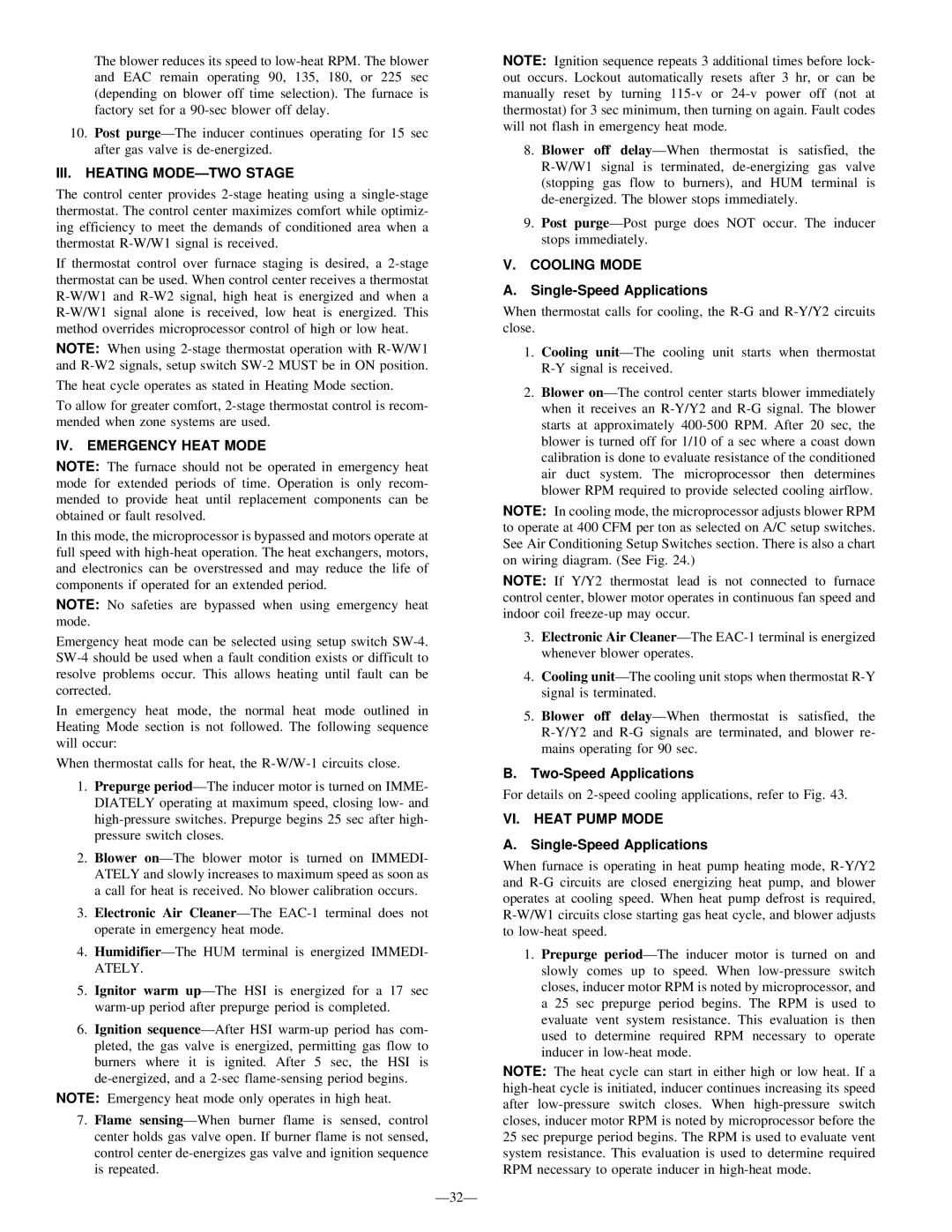The blower reduces its speed to low-heat RPM. The blower and EAC remain operating 90, 135, 180, or 225 sec (depending on blower off time selection). The furnace is factory set for a 90-sec blower off delay.
10.Post purgeÐThe inducer continues operating for 15 sec after gas valve is de-energized.
III.HEATING MODEÐTWO STAGE
The control center provides 2-stage heating using a single-stage thermostat. The control center maximizes comfort while optimiz- ing efficiency to meet the demands of conditioned area when a thermostat R-W/W1 signal is received.
If thermostat control over furnace staging is desired, a 2-stage thermostat can be used. When control center receives a thermostat R-W/W1 and R-W2 signal, high heat is energized and when a R-W/W1 signal alone is received, low heat is energized. This method overrides microprocessor control of high or low heat.
NOTE: When using 2-stage thermostat operation with R-W/W1 and R-W2 signals, setup switch SW-2 MUST be in ON position.
The heat cycle operates as stated in Heating Mode section.
To allow for greater comfort, 2-stage thermostat control is recom- mended when zone systems are used.
IV. EMERGENCY HEAT MODE
NOTE: The furnace should not be operated in emergency heat mode for extended periods of time. Operation is only recom- mended to provide heat until replacement components can be obtained or fault resolved.
In this mode, the microprocessor is bypassed and motors operate at full speed with high-heat operation. The heat exchangers, motors, and electronics can be overstressed and may reduce the life of components if operated for an extended period.
NOTE: No safeties are bypassed when using emergency heat mode.
Emergency heat mode can be selected using setup switch SW-4. SW-4 should be used when a fault condition exists or difficult to resolve problems occur. This allows heating until fault can be corrected.
In emergency heat mode, the normal heat mode outlined in Heating Mode section is not followed. The following sequence will occur:
When thermostat calls for heat, the R-W/W-1 circuits close.
1.Prepurge periodÐThe inducer motor is turned on IMME- DIATELY operating at maximum speed, closing low- and high-pressure switches. Prepurge begins 25 sec after high- pressure switch closes.
2.Blower onÐThe blower motor is turned on IMMEDI- ATELY and slowly increases to maximum speed as soon as a call for heat is received. No blower calibration occurs.
3.Electronic Air CleanerÐThe EAC-1 terminal does not operate in emergency heat mode.
4.HumidifierÐThe HUM terminal is energized IMMEDI-
ATELY.
5.Ignitor warm upÐThe HSI is energized for a 17 sec warm-up period after prepurge period is completed.
6.Ignition sequenceÐAfter HSI warm-up period has com- pleted, the gas valve is energized, permitting gas flow to burners where it is ignited. After 5 sec, the HSI is de-energized, and a 2-sec flame-sensing period begins.
NOTE: Emergency heat mode only operates in high heat.
7.Flame sensingÐWhen burner flame is sensed, control center holds gas valve open. If burner flame is not sensed, control center de-energizes gas valve and ignition sequence is repeated.
Ð32Ð
NOTE: Ignition sequence repeats 3 additional times before lock- out occurs. Lockout automatically resets after 3 hr, or can be manually reset by turning 115-v or 24-v power off (not at thermostat) for 3 sec minimum, then turning on again. Fault codes will not flash in emergency heat mode.
8.Blower off delayÐWhen thermostat is satisfied, the R-W/W1 signal is terminated, de-energizing gas valve (stopping gas flow to burners), and HUM terminal is de-energized. The blower stops immediately.
9.Post purgeÐPost purge does NOT occur. The inducer stops immediately.
V.COOLING MODE
A. Single-Speed Applications
When thermostat calls for cooling, the R-G and R-Y/Y2 circuits close.
1.Cooling unitÐThe cooling unit starts when thermostat R-Y signal is received.
2.Blower onÐThe control center starts blower immediately when it receives an R-Y/Y2 and R-G signal. The blower starts at approximately 400-500 RPM. After 20 sec, the blower is turned off for 1/10 of a sec where a coast down calibration is done to evaluate resistance of the conditioned air duct system. The microprocessor then determines blower RPM required to provide selected cooling airflow.
NOTE: In cooling mode, the microprocessor adjusts blower RPM to operate at 400 CFM per ton as selected on A/C setup switches. See Air Conditioning Setup Switches section. There is also a chart on wiring diagram. (See Fig. 24.)
NOTE: If Y/Y2 thermostat lead is not connected to furnace control center, blower motor operates in continuous fan speed and indoor coil freeze-up may occur.
3.Electronic Air CleanerÐThe EAC-1 terminal is energized whenever blower operates.
4.Cooling unitÐThe cooling unit stops when thermostat R-Y signal is terminated.
5.Blower off delayÐWhen thermostat is satisfied, the R-Y/Y2 and R-G signals are terminated, and blower re- mains operating for 90 sec.
B.Two-Speed Applications
For details on 2-speed cooling applications, refer to Fig. 43.
VI. HEAT PUMP MODE
A. Single-Speed Applications
When furnace is operating in heat pump heating mode, R-Y/Y2 and R-G circuits are closed energizing heat pump, and blower operates at cooling speed. When heat pump defrost is required, R-W/W1 circuits close starting gas heat cycle, and blower adjusts to low-heat speed.
1.Prepurge periodÐThe inducer motor is turned on and slowly comes up to speed. When low-pressure switch closes, inducer motor RPM is noted by microprocessor, and a 25 sec prepurge period begins. The RPM is used to evaluate vent system resistance. This evaluation is then used to determine required RPM necessary to operate inducer in low-heat mode.
NOTE: The heat cycle can start in either high or low heat. If a high-heat cycle is initiated, inducer continues increasing its speed after low-pressure switch closes. When high-pressure switch closes, inducer motor RPM is noted by microprocessor before the 25 sec prepurge period begins. The RPM is used to evaluate vent system resistance. This evaluation is used to determine required RPM necessary to operate inducer in high-heat mode.
